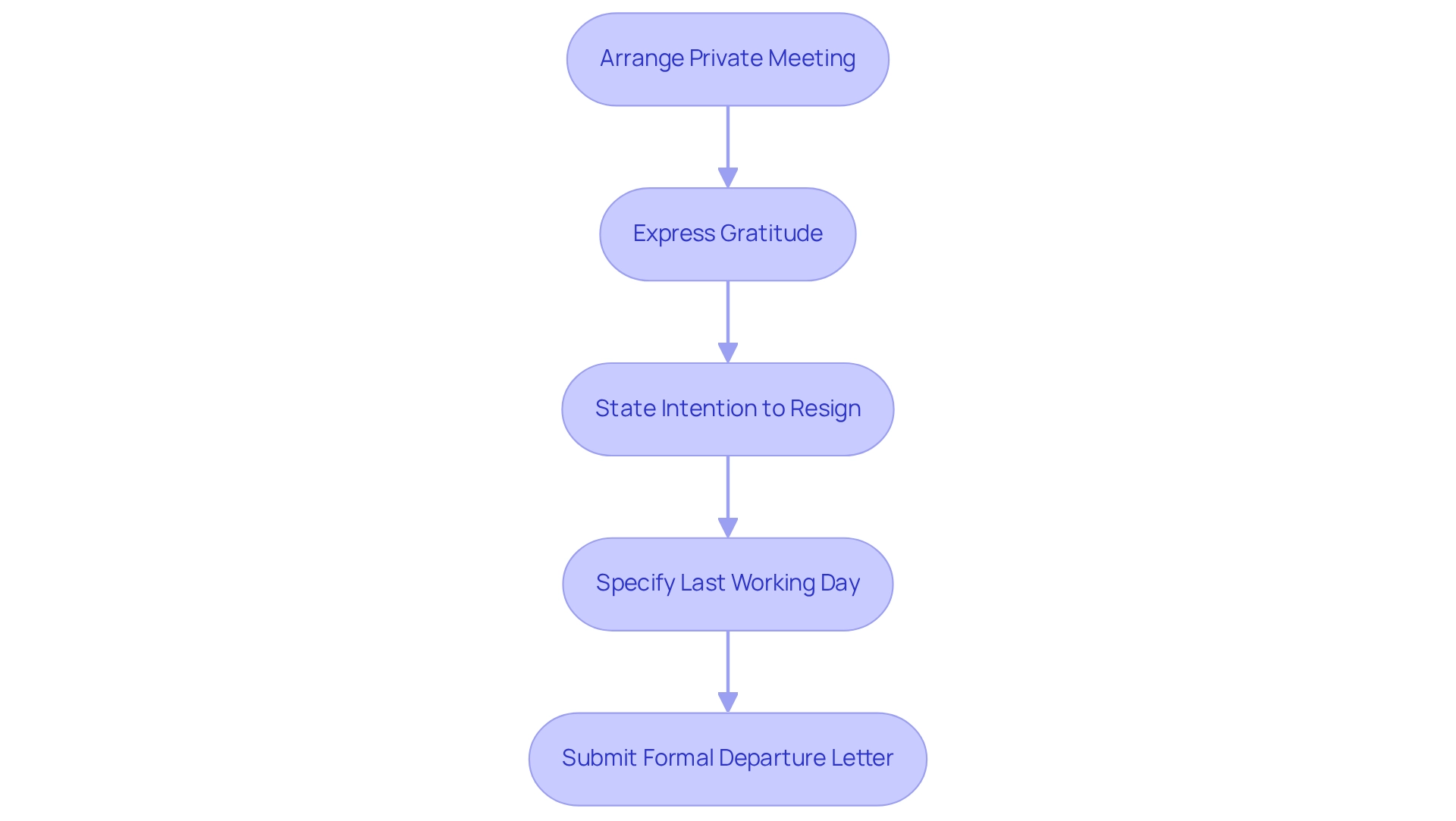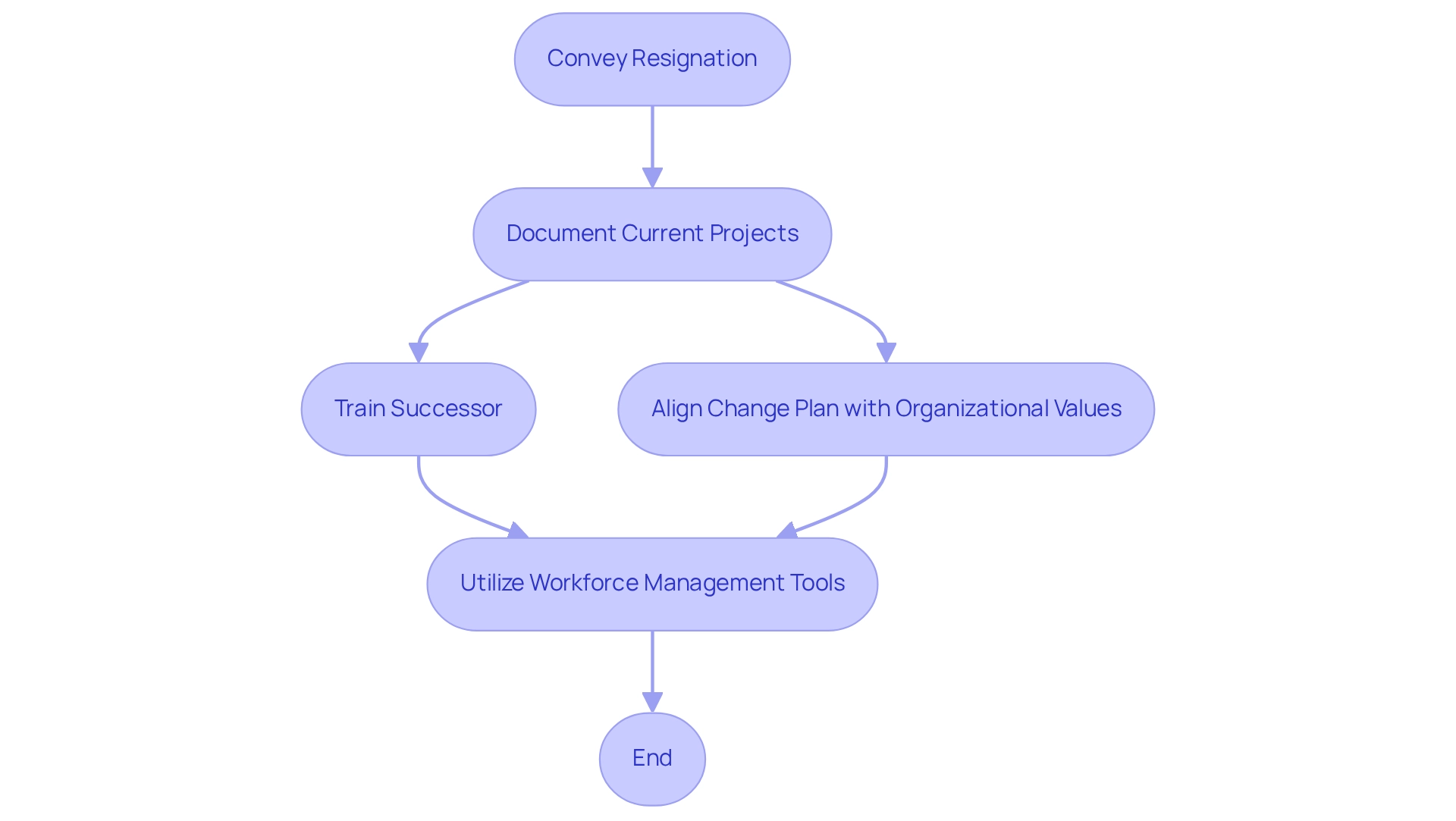Overview
To give notice at work effectively, it is essential to:
- Understand the required notice period
- Communicate professionally with your manager
- Prepare a thorough handover plan
Begin by reviewing your employment contract to grasp the specifics of your notice obligations. Next, express gratitude during resignation discussions—this not only fosters goodwill but also enhances your professional reputation. Documenting ongoing projects is crucial for a smooth transition, ensuring that your team can maintain continuity in your absence. By following these steps, you can cultivate a positive relationship with your employer, paving the way for future opportunities.
Key Highlights:
- Review your employment contract to understand the required notice period before resigning, which typically ranges from two weeks to four weeks for higher-level positions.
- Engage with HR for specific notice requirements and to support a smooth transition for both you and your employer.
- Employers often provide double the notice period required from employees, highlighting the importance of mutual respect during the resignation process.
- Communicate your resignation in a private meeting with your manager, expressing gratitude and clearly stating your last working day.
- Submit a formal resignation letter that reiterates your departure date and appreciation for your experiences at the company.
- Develop a thorough handover plan documenting projects and key contacts to ensure continuity for your successor.
- Offer to train your successor or assist in recruitment to demonstrate commitment to a smooth transition and enhance team morale.
- Align your transition plan with the organization’s values to foster a supportive atmosphere during your departure.
Introduction
Navigating the resignation process is not merely a task; it is a critical juncture that carries substantial weight for both employees and employers. The complexities of notice periods, effective communication, and transition planning are essential elements that contribute to a seamless departure. As workplace dynamics continue to evolve, so too do the expectations surrounding resignations. It is imperative for individuals to approach this transition with both professionalism and foresight. By exploring the key aspects of resigning gracefully, employees can cultivate positive relationships that may serve them well in future endeavors. Simultaneously, organizations can uphold continuity and morale during these pivotal changes.
Understand Your Notice Period Requirements
Before giving in notice at work, it is imperative to thoroughly review your employment contract or employee handbook to understand the required advance notification. Typically, the standard notification period for giving in notice at work is two weeks; however, this can vary significantly depending on your position or specific company policies. In 2025, many employers are expected to adhere to notification durations that may surpass the norm, with some requiring up to four weeks for higher-level roles. Engaging with your HR department can provide valuable insights into any specific requirements relevant to your situation, particularly concerning giving in notice at work, as understanding your notification timeframe is essential—not just for planning your next steps but also for facilitating a smooth transition for both you and your employer. Notably, statistics reveal that employers often must provide double the advance notice required of employees, underscoring the importance of mutual respect in the resignation process. For instance, a financial institution might require a senior executive to give four weeks’ notice, while the organization itself is anticipated to offer eight weeks’ notice should it decide to terminate the executive’s contract. Furthermore, numerous companies have adopted distinct notification time policies, including flexible arrangements for fixed-term contracts that allow for early termination under certain conditions.
Expert opinions emphasize that hiring individuals who align with the company’s values fosters greater commitment and performance from staff. This principle is equally relevant during the resignation process, particularly when giving in notice at work, as open communication about timelines can nurture a positive relationship while you transition to new opportunities. As HR professionals, being knowledgeable and respectful of notice period requirements not only cultivates a professional environment that values transparency and collaboration but also paves the way for a constructive exit process. By grasping these requirements, you can better support your organization and ensure a seamless transition for all parties involved.
Communicate Your Resignation Professionally
Arrange a private meeting with your manager to discuss your departure. Start by expressing gratitude for the opportunities you have enjoyed within the organization; this establishes a positive tone for the conversation. Clearly state your intention to resign, ensuring you are giving in notice at work and specifying your last working day to eliminate any ambiguity. Keep the discussion straightforward—there is no need to delve into excessive detail about your reasons for leaving unless you feel comfortable doing so.
In today’s competitive job market, often referred to as a ‘war for talent,’ leading candidates are selective and assess prospective employers carefully. Maintaining positive connections during departures is essential. Intelligent and resourceful candidates are seeking the right fit, and a positive departure can significantly enhance your professional reputation. Following this meeting, it is crucial to submit a formal departure letter as part of giving in notice at work. This letter should reiterate your departure date and express appreciation for the support and experiences gained during your tenure. Such professionalism not only preserves your relationship with your employer but also enhances your career reputation.
As Marija Kojic notes, choosing the right communication method is vital; online chat tools remain a popular platform for work-related communications. Incorporating expert advice on resigning gracefully can further enhance your approach, ensuring that you leave on a positive note while being mindful that candidates are assessing their future employers even during this process.

Prepare for a Smooth Transition After Resignation
After conveying your resignation, it’s essential to concentrate on developing a thorough handover plan. Begin by documenting your current projects, responsibilities, and key contacts that your successor will need to ensure continuity. This step is crucial, as research shows that 13% of individuals with postgraduate degrees reported leaving their jobs, underscoring the need for effective strategies to retain talent and reduce disruption.
Offering to train your successor or assist in the recruitment process not only aids your team but also demonstrates your commitment to a seamless handover. Studies indicate that over 90% of workers believe the appropriate type of workplace training positively impacts their job engagement, emphasizing the significance of training during the transition. By actively engaging in the development of your successor, you can enhance overall team morale and productivity. Furthermore, aligning your change plan with the organization’s values can strengthen a positive employee experience. For instance, 92% of survey respondents believe that training goals should focus on diversity, engagement, and a growth mindset. Incorporating these values into your training strategy can foster a more inclusive and supportive atmosphere during your change. Additionally, utilizing workforce management tools can enhance retention by providing necessary data for informed decisions, further supporting a smooth transition.
By taking these proactive steps, you leave a lasting positive impression, ensuring that your departure is viewed favorably by both your colleagues and management. In summary, a well-structured transition plan not only benefits your successor but also contributes to the overall health of the organization, making it essential for a successful resignation process when giving in notice at work.

Conclusion
Navigating the resignation process with professionalism and foresight is essential for both employees and employers. Understanding notice period requirements is a fundamental step, as it allows individuals to plan their next moves while ensuring a smooth transition for the organization. By consulting employment contracts and HR guidelines, employees can respect the expectations set by their employers, fostering a positive atmosphere during this critical time.
Effective communication plays a vital role in resignations. Scheduling a private meeting with a manager to express gratitude and clearly state the intention to resign sets a constructive tone. Following up with a formal resignation letter reinforces professionalism and helps maintain valuable relationships, which is increasingly important in today’s competitive job market. A positive exit can reflect well on an individual’s professional reputation, opening doors for future opportunities.
Moreover, preparing a comprehensive transition plan is crucial for minimizing disruption and supporting team morale. Documenting responsibilities and offering to train successors not only aids in continuity but also enhances the overall employee experience. Aligning transition strategies with organizational values can create a more inclusive environment, leaving a lasting impression on colleagues and management alike.
Ultimately, resigning gracefully is a multifaceted process that benefits all parties involved. By approaching this transition thoughtfully, individuals can cultivate positive relationships and uphold their professional integrity, paving the way for future success.
Frequently Asked Questions
What should I do before giving notice at work?
Before giving notice at work, it is important to thoroughly review your employment contract or employee handbook to understand the required advance notification period.
What is the standard notification period for giving notice at work?
The typical standard notification period for giving notice at work is two weeks, but this can vary based on your position or specific company policies.
Are there any changes expected in notification durations for 2025?
Yes, in 2025, many employers are expected to adhere to notification durations that may exceed the standard, with some requiring up to four weeks for higher-level roles.
How can I find out about specific notice requirements?
Engaging with your HR department can provide valuable insights into any specific requirements relevant to your situation regarding giving notice at work.
Why is understanding the notification timeframe important?
Understanding your notification timeframe is essential for planning your next steps and facilitating a smooth transition for both you and your employer.
Do employers have different notice requirements compared to employees?
Yes, statistics show that employers often must provide double the advance notice required of employees, highlighting the importance of mutual respect in the resignation process.
Can you give an example of notice requirements for different roles?
For instance, a financial institution might require a senior executive to give four weeks’ notice, while the organization itself may offer eight weeks’ notice if it decides to terminate the executive’s contract.
Are there flexible arrangements for fixed-term contracts?
Yes, many companies have adopted distinct notice time policies, including flexible arrangements for fixed-term contracts that allow for early termination under certain conditions.
How does open communication about timelines impact the resignation process?
Open communication about timelines can nurture a positive relationship during the resignation process, fostering greater commitment and performance from staff.
What is the role of HR professionals in the notice period process?
HR professionals should be knowledgeable and respectful of notice period requirements to cultivate a professional environment that values transparency and collaboration, ensuring a constructive exit process.
